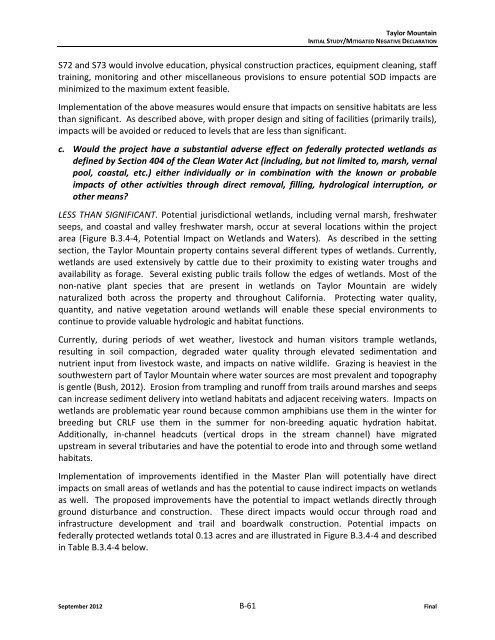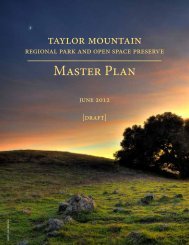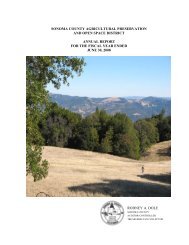Initial Study MND - Sonoma County Agricultural Preservation and ...
Initial Study MND - Sonoma County Agricultural Preservation and ...
Initial Study MND - Sonoma County Agricultural Preservation and ...
Create successful ePaper yourself
Turn your PDF publications into a flip-book with our unique Google optimized e-Paper software.
Taylor MountainINITIAL STUDY/MITIGATED NEGATIVE DECLARATIONS72 <strong>and</strong> S73 would involve education, physical construction practices, equipment cleaning, stafftraining, monitoring <strong>and</strong> other miscellaneous provisions to ensure potential SOD impacts areminimized to the maximum extent feasible.Implementation of the above measures would ensure that impacts on sensitive habitats are lessthan significant. As described above, with proper design <strong>and</strong> siting of facilities (primarily trails),impacts will be avoided or reduced to levels that are less than significant.c. Would the project have a substantial adverse effect on federally protected wetl<strong>and</strong>s asdefined by Section 404 of the Clean Water Act (including, but not limited to, marsh, vernalpool, coastal, etc.) either individually or in combination with the known or probableimpacts of other activities through direct removal, filling, hydrological interruption, orother means?LESS THAN SIGNIFICANT. Potential jurisdictional wetl<strong>and</strong>s, including vernal marsh, freshwaterseeps, <strong>and</strong> coastal <strong>and</strong> valley freshwater marsh, occur at several locations within the projectarea (Figure B.3.4-4, Potential Impact on Wetl<strong>and</strong>s <strong>and</strong> Waters). As described in the settingsection, the Taylor Mountain property contains several different types of wetl<strong>and</strong>s. Currently,wetl<strong>and</strong>s are used extensively by cattle due to their proximity to existing water troughs <strong>and</strong>availability as forage. Several existing public trails follow the edges of wetl<strong>and</strong>s. Most of thenon-native plant species that are present in wetl<strong>and</strong>s on Taylor Mountain are widelynaturalized both across the property <strong>and</strong> throughout California. Protecting water quality,quantity, <strong>and</strong> native vegetation around wetl<strong>and</strong>s will enable these special environments tocontinue to provide valuable hydrologic <strong>and</strong> habitat functions.Currently, during periods of wet weather, livestock <strong>and</strong> human visitors trample wetl<strong>and</strong>s,resulting in soil compaction, degraded water quality through elevated sedimentation <strong>and</strong>nutrient input from livestock waste, <strong>and</strong> impacts on native wildlife. Grazing is heaviest in thesouthwestern part of Taylor Mountain where water sources are most prevalent <strong>and</strong> topographyis gentle (Bush, 2012). Erosion from trampling <strong>and</strong> runoff from trails around marshes <strong>and</strong> seepscan increase sediment delivery into wetl<strong>and</strong> habitats <strong>and</strong> adjacent receiving waters. Impacts onwetl<strong>and</strong>s are problematic year round because common amphibians use them in the winter forbreeding but CRLF use them in the summer for non-breeding aquatic hydration habitat.Additionally, in-channel headcuts (vertical drops in the stream channel) have migratedupstream in several tributaries <strong>and</strong> have the potential to erode into <strong>and</strong> through some wetl<strong>and</strong>habitats.Implementation of improvements identified in the Master Plan will potentially have directimpacts on small areas of wetl<strong>and</strong>s <strong>and</strong> has the potential to cause indirect impacts on wetl<strong>and</strong>sas well. The proposed improvements have the potential to impact wetl<strong>and</strong>s directly throughground disturbance <strong>and</strong> construction. These direct impacts would occur through road <strong>and</strong>infrastructure development <strong>and</strong> trail <strong>and</strong> boardwalk construction. Potential impacts onfederally protected wetl<strong>and</strong>s total 0.13 acres <strong>and</strong> are illustrated in Figure B.3.4-4 <strong>and</strong> describedin Table B.3.4-4 below.September 2012 B-61 Final







